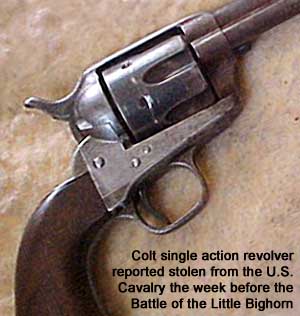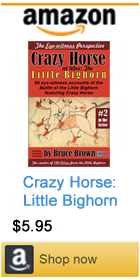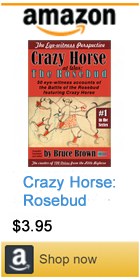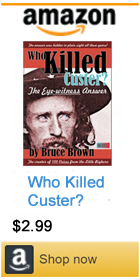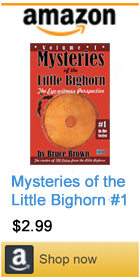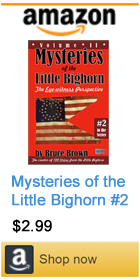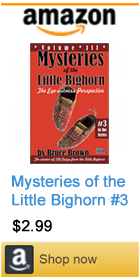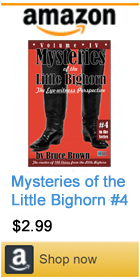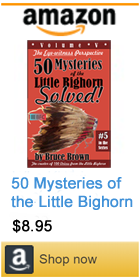|
||||||||||||
Bruce Brown's 100 Voices... George Herendeen's Story of the Battle
THE STATEMENTS OF GEORGE HERENDON GEORGE HERENDON, a scout sent by General Terry with General Custer's column, relates the following as his experience in the recent battle. He was sent by General Terry from the mouth of the Rosebud with General Custer's command to carry despatches to Terry from Custer: "Bismarck, D. T. July 7, 1876 "We left the Rosebud on the 22d of June at twelve o'clock; marched up the Rosebud about twelve miles and encamped for the night. On the morning of the 23d we broke camp at five o'clock and continued up the Rosebud until nine o'clock, when we struck a large lodge pole trail about ten days old and followed it along the Rosebud until toward evening, when we went into camp on the trail. On the morning of the 24th we pulled out at five o'clock and followed the trail five or six miles, when we met six Crow Indian scouts, who had been sent out the night previous by General Custer to look for the Indian village. They said they had found fresh pony tracks and that ten miles ahead the trail was fresher. General Custer had the officers' call sounded and they assembled around him, but I did not hear what he said to them. The scouts were again sent ahead and moved along at a fast walk. We moved at one o'clock, and, while the officers were eating their lunch, the scouts came back and reported that they had found where the village had been quite recently. They moved again, with flankers well out to watch the trail and see that it did not divide. About four o'clock we came to the place where the village had apparently been only a few days before, and went into camp two miles below the forks of the Rosebud. The scouts all again pushed out to look for the village, and at eleven o'clock at night Custer had everything packed up and followed the scouts up the right hand fork of the Rosebud.
"Eleven of the thirteen said they would go, but two stayed behind. I deployed the men as skirmishers and we moved forward on foot toward the river. When we had got nearly to the river we met five Indians on ponies, and they fired on us. I returned the fire and the Indians broke and we then forded the river, the water being breast deep. We finally got over, wounded men and all, and headed for Reno's command, which I could see drawn up on the bluffs along the river about a mile off. We reached Reno in safety. We had not been with Reno more than fifteen minutes when I saw the Indians coming up the valley from Custer's fight. Reno was then moving his whole command down the ridge toward Custer. The Indians crossed the river below Reno and swarmed up the bluff on all sides. After skirmishing with them Reno went back to his old position which was on one of the highest points along the bluffs. It was now about five o'clock and the fight lasted until it was too dark to see to shoot. As soon as it was dark Reno took the packs and saddles off the mules and horses and made breastworks of them. He also dragged dead horses and mules on the line and sheltered the men behind them. Some of the men dug rifle pits with their butcher knives and all slept on their arms. At the peep of day the Indians opened a heavy fire and a desperate fight ensued, lasting until ten o'clock. The Indians charged our position three or four times, coming up close enough to hit our men with stones, which they threw by hand. Captain Benteen saw a large mass of Indians gathering on his front to charge, and ordered his men to charge on foot and scatter them. Benteen led the charge and was upon the Indians before they knew what they were about, and killed a great many. They were evidently much surprised at this offensive movement, and I think in desperate fighting Benteen is one of the bravest men I ever saw in a fight. All the time he was going about through the bullets, encouraging the soldiers to stand up to their work, and not let Indians whip them. "I forgot to state that about ten o'clock in the forenoon, and soon after Benteen made his charge, the men began to clamor for water. Many of them had not tasted water for thirty-six hours, and the fighting and hot sun parched their throats. Some had their tongues swollen and others could hardly speak. The men tried to eat crackers and hardtack, but could not raise enough saliva to moisten them. Several tried grass, but it stuck to their lips, and not one could spit or speak plainly. The wounded were reported dying from want of water, and a good many soldiers volunteered to go to the river to get some or perish in the attempt. We were fighting on the bluffs, about 700 yards from the river, and a ravine led down from the battlefield close to the river's edge. The men had to run over an open space of about 100 yards to get into the head of the ravine, and this open space was commanded by the Indians on the bluffs. The soldiers, about fifty strong, dashed over the open plateau and entered the ravine. They rushed down it to the mouth and found it closely guarded by a party of Indians posted in the timber across the river. The water could be approached to within about thirty feet under cover; but then one had to step out on the river bank and take the Indian's fire. The boys ran the gauntlet bravely. Some would dash down to the river with camp kettles, fill them, and then take shelter in the bend of the ravine, behind the rocks, and there canteens were filled and carried up the hill. Before all the men and wounded men were supplied one man was killed and six or seven wounded in the desperate attempt. One man had the bone of his leg shattered by a ball, and it has since been amputated. [Note: here is Mrs. Spotted Horn Bull's cheerful recollection of the water brigade slaughter.] "About two o'clock the Indians began drawing off, but kept skirmishing until late in the afternoon, and near dark all drew off. We now got water for the animals, many of them being almost dead, and they were put to graze on the hillside. "In the evening. Colonel Reno changed his position and fortified the new one, it being higher and stronger than the old one. We expected the Indians would renew the attack next day, but in the morning not an Indian was to be found. Every one felt sure that Crook or Terry was coming to our relief, and Colonel Reno sent out runners. About ten o'clock the glad intelligence was received that General Terry, with a large column of troops, was moving up the valley, six miles distant, and the head of his column soon came in sight."
"I went in with the scouts on the left of Reno's line. There were about sixty of us, thirty-five being Ree Indians, six friendly Sioux, six Crows and the rest white men. I saw Bloody Knife, a Ree scout, throw up his arm and fall over, and I think he was killed. The two cavalry soldiers I left in the timber when I went out I have no doubt were killed, as they have not been seen since. [Note: actually Lt. DeRudio and Pvt. O'Neill survived.] "I saw Lieutenant McIntosh soon after he fell. He had his horse shot under him early in the action, and at the time he was killed he was riding a soldier's horse. He was shot on the river bank while riding back to the ford. "I saw Lieutenant Hodgson also. His horse was shot and he was wounded. His horse fell into the river near the opposite bank of the ford, and to help himself up the steep bank Hodgson caught hold of a horse's tail and had got up the bank when an Indian sharpshooter picked him off. Custer's packs were with the rest, and the Indians did not get any of them. Neither did they get any mules. Most of Custer's horses were shot in the action, and I do not believe the Indians got over 100 animals by the fight.
"I think the Indian village must have contained about 6,000 people, fully 3,000 of whom were warriors. The Indians fought Reno first and then went to fight Custer, after which they came back to finish Reno. The same Indians were in all the attacks. I think the Indians were commanded by Sitting Bull in person. There were eight or nine other chiefs in the field. "I saw five chiefs, and each one carried a flag for their men to rally around. Some of the flags were red, others yellow, white and blue, and one a black flag. All the chiefs handled their warriors spendidly. I think Crazy Horse and his band were in the fight. The Indians must have lost as many men in killed and wounded as the whites did. "Custer's men made a good fight, and no doubt killed a great many Indians. I don't think a single man escaped from Custer's part of the field. They were completely surrounded on every side by at least 2,500 warriors." The Custer Myth: A Source Book of Custerania, written and compiled by Colonel W.A. Graham, The Stackpole Co., Harrisburg, PA 1953, p. 257 - 260
NOTE: George Herendeen (also spelled Herendon, Herndon and other ways) was a white Army scout assigned by General Alfred Terry to accompany Custer's Seventh Cavalry in June 1876 for the purpose of keeping Terry -- Custer's commanding officer -- informed of Custer's movements. Herendeen's letter was written July 7, 1876 -- 13 days after the Battle of the Little Bighorn -- and published by the Helena Herald the next day. Herendeen's account of the Battle of the Little Bighorn is important for a raft of detailed, first-hand observations The latter shows that Custer knew the Indians weren't running away from Reno, as Half Yellow Face originally reported to Custer. Instead, the free Sioux and Cheyenne were swarming to attack Reno -- information that Crow scouts Hairy Mocassin, White Man Runs Him and Goes Ahead also reported to Custer. That meant Custer knew he himself had to attack immediately to keep the much larger Indian force off balance and proivide Reno's 112 men the support he promised -- otherwise he had sent Reno on a suicide mission. And this in turn underlines the fact that the ONLY plausible explanation for the 20-minute delay after Custer initially charged the huge village was that Custer was shot trying to cross the river -- as White Cow Bull described, and Pretty Shield confirmed -- and was no longer commanding his men. See Astonisher.com's Who Killed Custer - The Eye-witness Answer for more info...
|
||||||||||||



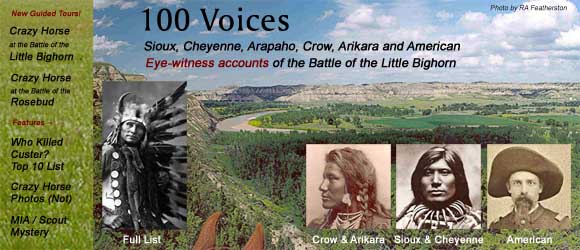
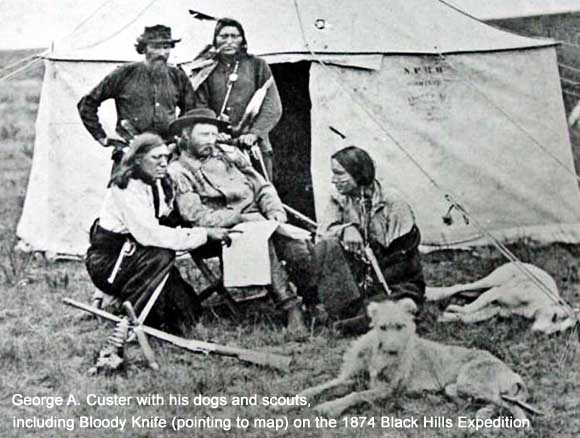
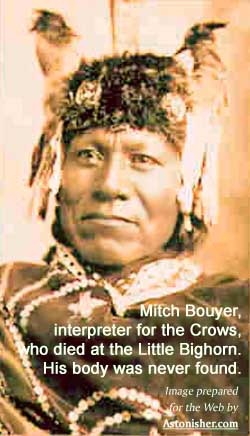 "
"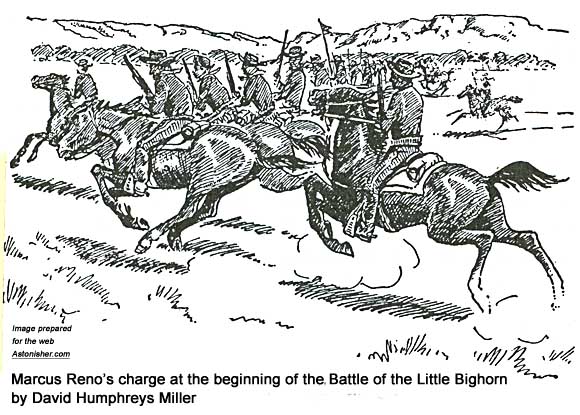
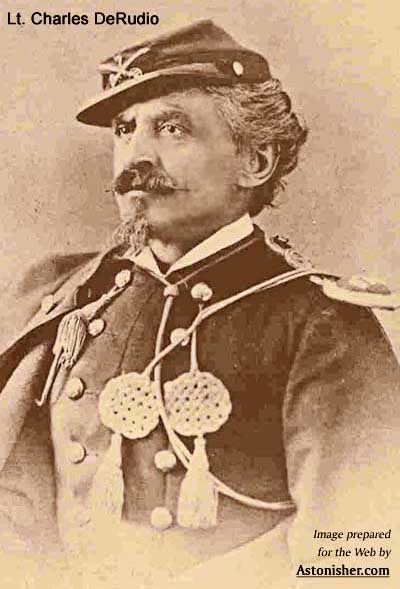 In reply to questions, Mr. Haynden said:
In reply to questions, Mr. Haynden said: